Peking duck is one of the most common breeds in the world. Meat breed bred by breeding in the XVIII century in Beijing. It quickly spread throughout China and took a dominant position. After some time, the bird was brought to America and Europe. Due to its high productivity and excellent meat qualities, the Peking duck has supplanted many native breeds and today it is bred at home.
Table of contents
Breed description
Torso has an elongated and raised look. Body type powerful, broad chest, long back, tail raised. A large, tall head is located on a thick curved neck, a convex frontal part. Low fat legs are located closer to the tail and have an orange-red color. Wings strong, tight to the body, stand out for their power and large scale. Dark blue, large, shiny eyes. Orange beak is medium in size, slightly curved. Plumage white, high density. Muscle It is characterized by considerable density, a small layer of connective tissue. Detailed description, characteristics and reviews of farmers about the breed, see below.
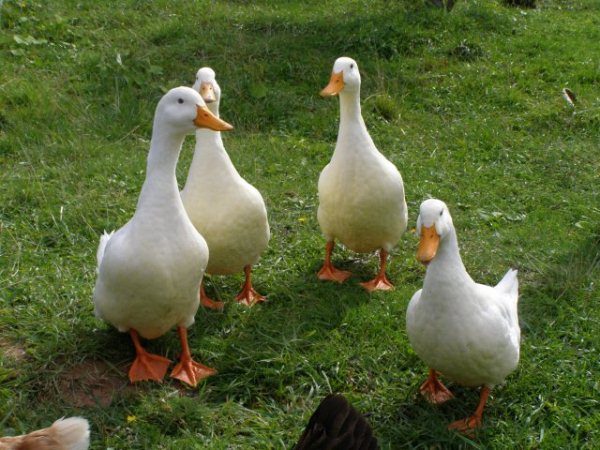
Peking duck is characterized restless temperamentthat is due to its rapidly excitable nervous system. The bird often screams that it causes some trouble to some breeders. To avoid noise for ducks create a favorable and calm living conditions, if you eliminate all external stimuli, the bird behaves calm and quiet.
Conditions of detention and cultivation
Peking duck rearing, both in industrial and in home farms, is quite simple and profitable a business. Knowing the main nuances and observing content requirements and feeding can be achieved in record time.
On an industrial basis the bird is found in specially equipped rooms. Poultry houses are equipped artificial lighting, heating, automatic feed and water. The microclimate is monitored and all hygiene standards are observed.
In homestead farms for Peking ducks they build poultry houses or adapt existing premises. The house should be made of bricks, without cracks and holes. If possible, the room is insulated, which reduces heating costs in the winter. Heat should not go through the roof or floor, if the windows are old, they must be sealed. No rooms with earthen or wooden floors are allowed. Floors are made of concrete. Good floor not only will keep heat, but also will not allow penetration into the shed of rats that are capable of causing irreparable harm to the bird.
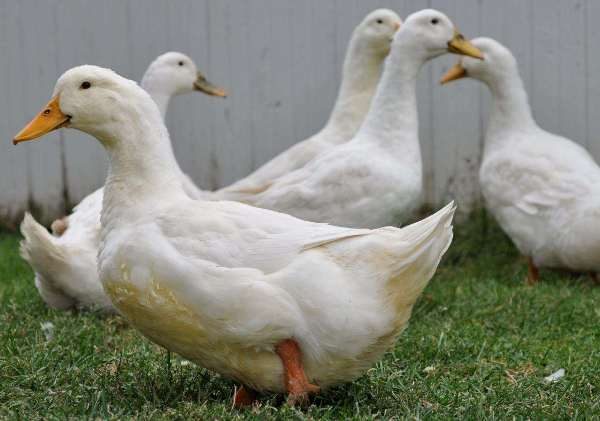
Laz is made in the south side, the hole should be well closed by the door and is at a height of 5-8 cm from the floor. The height of the hole is 30-40 cm and width is 40 cm. If the duck is contained on the litter, the hole is increased by 20-40 cm. For high productivity birds need normal lighting. Artificial lighting is set at the rate of 1 square meter of floor 5 watts. Reflectors are hung on the bulbs. Concerning natural lightingthen on 1 square. m floor should go 100 cm2 windows. In winter, due to lack of light, egg production is reduced, so the daylight hours are extended to 12 hours a day due to artificial lighting.
In each house must be nestsThey are made of plywood or tesa. Normal socket options: 40x50, height 50 cm. A threshold of 8-10 cm is made at the entrance to the nest. Nests are placed along the side walls of the house in dark places so that other birds do not disturb the duck.
Feeders are made of wood, the thickness of which is 2-2.5 cm. Since birds often scatter feed, a plank is attached from above so that the duck cannot climb inside. Length of adult bird feeders - 110 cm, and for young stock 100.The width for adults is 23 cm, for young stock 14.5 cm. Feeders are made with several compartments, so that you can give out mineral feeds. Vacuum drinkers are recommended for both young and adult individuals.
In summer, the Peking duck is advisable. keep on the runs and drive into the room only at night. On runs, as in the house, set feedersand if there is no access to the reservoir, then drinking bowls. Summer maintenance can reduce the cost of funds due to grass and reduce labor costs per unit of production.
In the house no drafts allowed. In winter, the temperature should not fall below 5 ° C. Optimal temperature in the house 16 ° С, with a humidity of 60-70%. Due to the down coat, ducks tolerate frosts and retain heat at the expense of their own body. Low temperatures are poorly tolerated if the bird has a dirty plumage. The cleanliness of the ducks directly depends on the condition of the house, which must be cleaned and ventilated regularly. As deep litterand use sawdust, straw, shavings and flax. Deep bedding maintains a normal climate in the house, absorbs moisture and produces heat, due to the decomposition of organic matter. In a year on 1 head there is 20 kg of a laying. Accommodation rate on 1 square.m: 2-3 adults or 6-8 heads of young animals.
In addition to the floor content of the Peking ducks can be grown in cages. Cells are placed in the house in several tiers, the floor is made of slats or grid so that the legs of the bird do not fall through the holes. With this content, ducks eat well, move a little and grow quickly, which makes it possible to get profit much faster.
Breed characteristic
Live weight of drake - 3.6-4.2 kg, ducks - 3.4-3.9 kg. At 2 months of age, young animals weigh 2.2-2.6 kg. Ducks start laying eggs at 23 weeks, egg-laying time is 42 days, hatchability - 85-88%. Egg production - 100-140 eggs per year. Large eggs - 85-90 g. Shell thickness - 0.38 mm. High egg production lasts for 2-3 years. Daily feed intake per 1 head - 340 g. Slaughter yield - 67%. Body temperature 42.2 ° С, ducks breathe with a frequency of 30-34 respiratory movements per minute. 5 ducks are attached to 1 drake, i.e. family consists of 6 individuals.
Cultivation and feeding
When feeding the Peking duck, it is necessary to take into account the structural features of this breed. Peking ducks have accelerated metabolism. The small intestine promotes the rapid absorption of food (4 hours).Given these nuances, the bird must be constantly provided with food, which, in turn, contributes to the rapid weight gain.
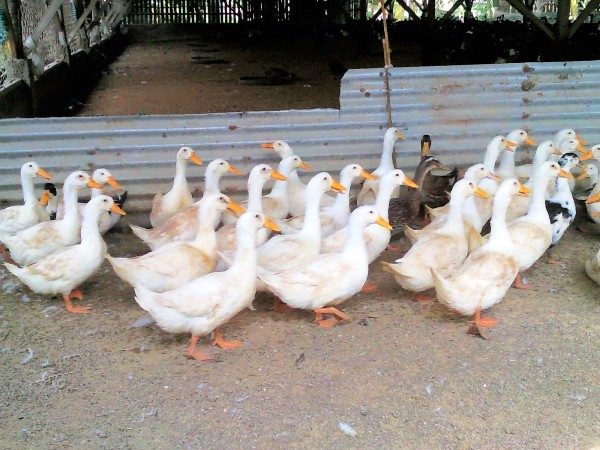
Peking ducks good grow on ground feed and feed. The ratio of feed to water is 1k4. One adult per day has an average of 1 liter of water. Birds are sensitive to feed changes and disturbances in feeding regimes.
Feeding occurs 3 times a day. In the morning and in the afternoon, wet food is given, and in the evening, cereals, in accordance with the norms and feed rations. Mixes prepared immediately before feeding and given fresh, in no case can not be fed soured foods. During the feeding period the bird must be free. access to water. On average, a duck a day should get 80 g of oats, 75 g of barley, 60 g of bran, 40 g of fodder beet, 15 g of lentils or peas, 40 g of greenery, 11 g of animal feed, 4 g of bone meal, 9 g of chalk and 1 g of salt.
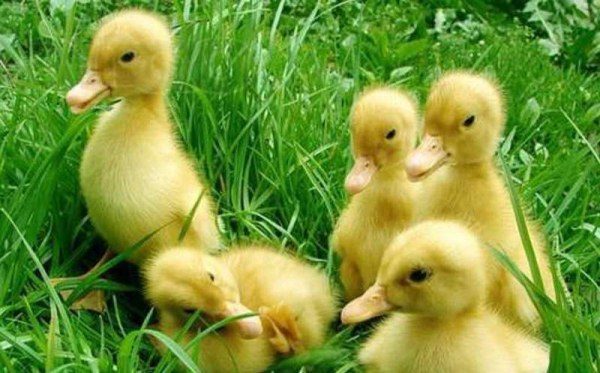
Feeding the chicks begins after the plumage has dried. In the early days give crushed boiled egg, it is possible with the addition of cottage cheese. After a few days in the diet is introduced starter feed and chopped greens. Feed the kids need at least 5 times a day. Milled egg shells will be suitable as a mineral feed. Youngsters should be provided with vitamin supplements.
Diseases and care
Despite the fact that Peking ducks belong to resistant species of birds, they are still subject to some diseases.
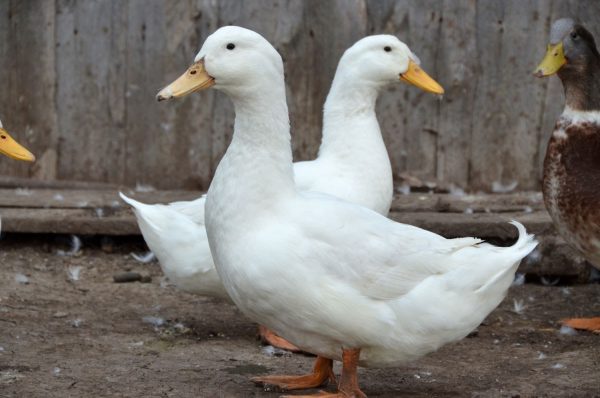
Avitaminosis
At avitaminosis birds become sluggish, appetite disappears, coordination of movement is disturbed, growth slows down, wings sag, eyes become inflamed, convulsions appear and fluid is released from the nostrils. A lack of vitamin D can lead to rickets. A balanced diet is the only way to fight against avitaminosis and if a bird develops symptoms of the disease, then there is a lack of any element in the feed.
Goiter diseases
The cause of the disease can be sticky foodswallowing foreign objects or large food.If the bird does not immediately help, then the disease can go into the chronic stage and the goiter will stop shrinking. When a goiter is blocked, you should try to clean it yourself, holding the duck by the legs with its head upside down. If the problem is serious, it is strongly recommended to call the vetwho will conduct an autopsy goiter.
Coccidiosis
Infection, leading to lethargy, decreased egg production, poor appetite and blood frothy stools. Transmitted through food and feeding supplies. The first diseased individual must be isolated from the common herd. To prevent coccidiosis, coccidin and sulfadimezin are added to the water. Infected poultry house disinfect with 3% formalin solution and a weak solution of potassium permanganate.
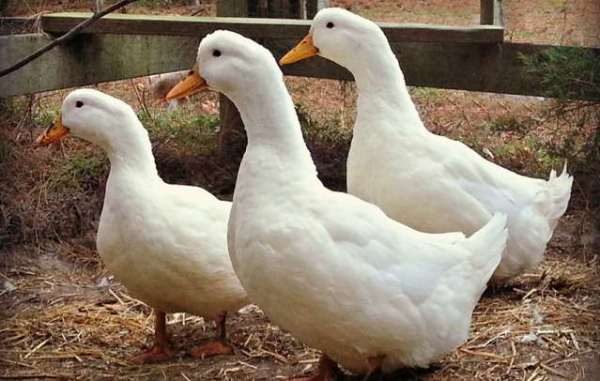
Aspergillosis
This disease most often affects ducklings and can lead to a large the fall of young. With aspergillosis, ducks breathe heavily, wheezing appears, liquid is released from the beak, birds convulsively swallow air, appetite decreases, growth slows down, paralysis of legs or wings is possible. To eliminate the disease, all remnants of food and litter are thrown away, equipment and house are disinfected. Added to feed nystatinand 0.05% water solution copper sulphate.
Pasteurellosis or cholera
This disease, although infrequent, is very serious. It is transmitted through the air, feed and equipment. With cholera in ducks, apathy sets in, body temperature rises, thirst appears and appetite disappears, frothy discharges from the nose, and loose stools with blood. Infected birds are killed, their place of residence is disinfected. Healthy but contacting birds with infected individuals, biomitsin is injected, and sulfadimezin is given.
Advantages and disadvantages of the Peking duck breed
Advantages:
- Good adapt to cold weather.
- Differ high early maturity.
- Unpretentious in feeding.
- With the content there is no urgent need for reservoirs.
Disadvantages:
- Ducks are not prone to brooding.
- Get sick and fall to their feet in the damp.
Peking duck - This is one of the best and unpretentious meat breeds. It has a high productivity and good meat qualities. Ideal for industrial and domestic breeding, and due to precocity, the period of profit is reduced several times compared with other breeds.
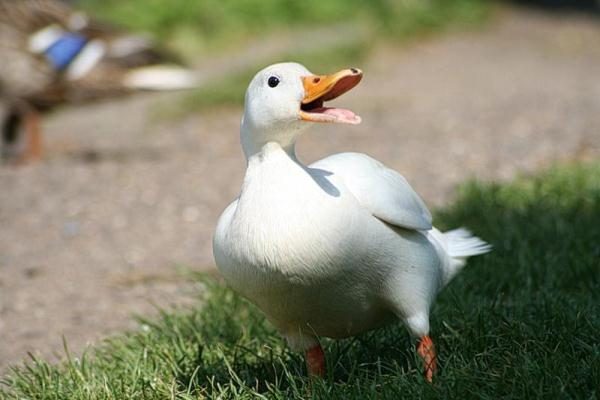
Reviews
Peking duck is the best option if you want to breed beef. Gutted carcass weighs 2-2.5 kg. Young meat is very tasty and not tough. The normal percentage of fat, it is just a little and, at the same time, the meat is not dry. It is better to incubate in the incubator, because there is little sense from the hen. Of the 10 eggs on average, 8 healthy and viable chicks hatch. AT feed peking ducks It should not be limited, but there is no need to give a lot of food either, since they like to scatter it. Water should be constantly, and if there is an opportunity, it is better to let out to the reservoir. If you breed for yourself, then by the autumn you can get a full-fledged duck, ready for slaughter.
White beautiful Peking ducks have become a favorite breed of many farmers. They do not require special costs for keeping and feeding. Ducks give a year 120 eggsthat are perfectly incubated. They grow very fast and in 2 months weight of ducks already reaches 3 kg. Food is consumed moderately, and if you buy modern feeders, then its consumption will be much reduced. Birds are well tolerated low temperatures, and in a warmed poultry house it is necessary to heat only during severe frosts. In general, it is very profitable to grow Peking ducks, and most importantly, quickly and with minimal expenditure of money and care.
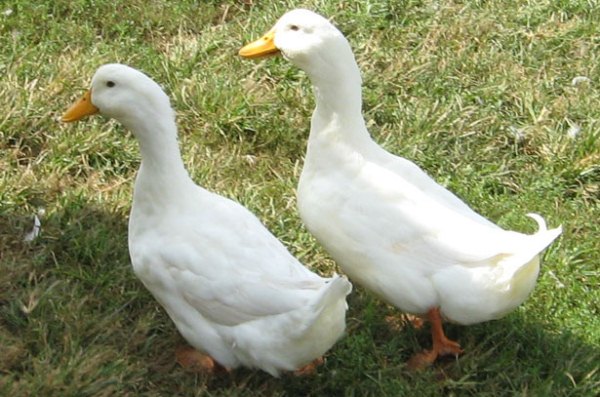
How many ducks sit on eggs?
Evgenia, 27-29 days.
How to get out of the Peking ducks Millard?
How can u get the mulardov to cross with whom?